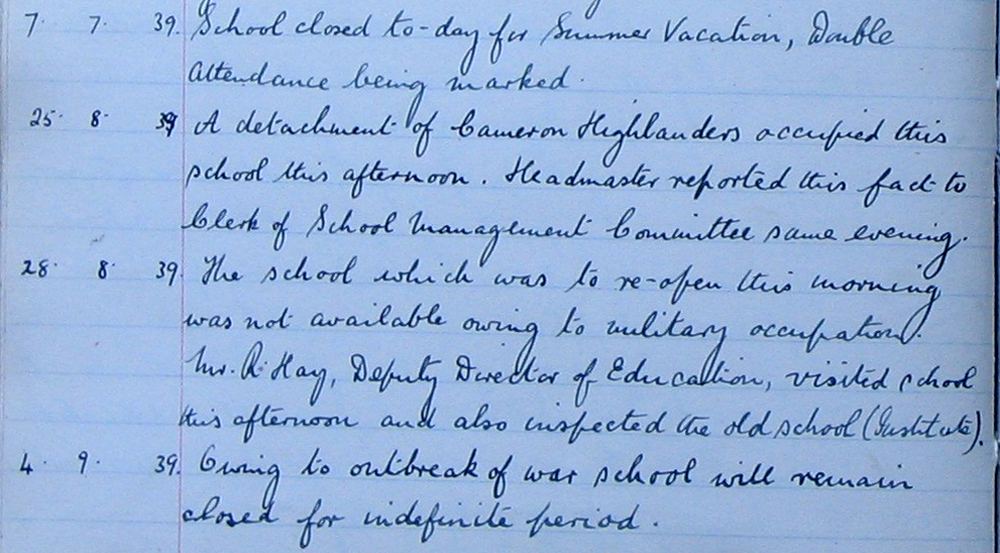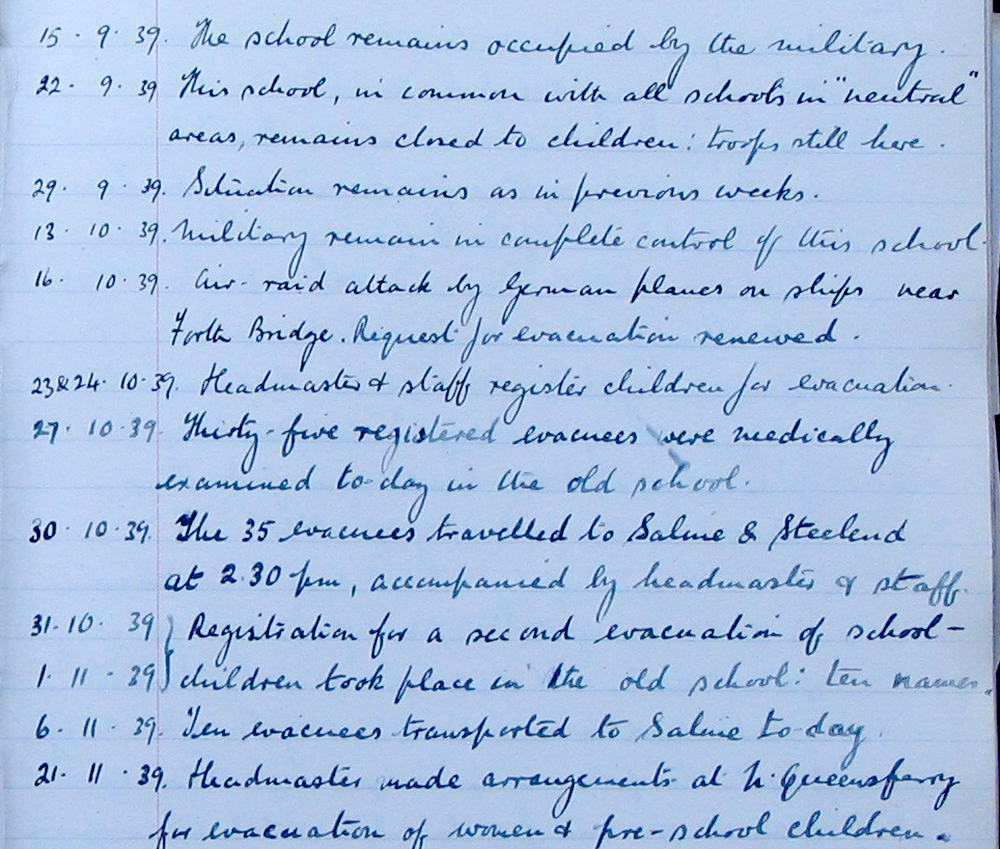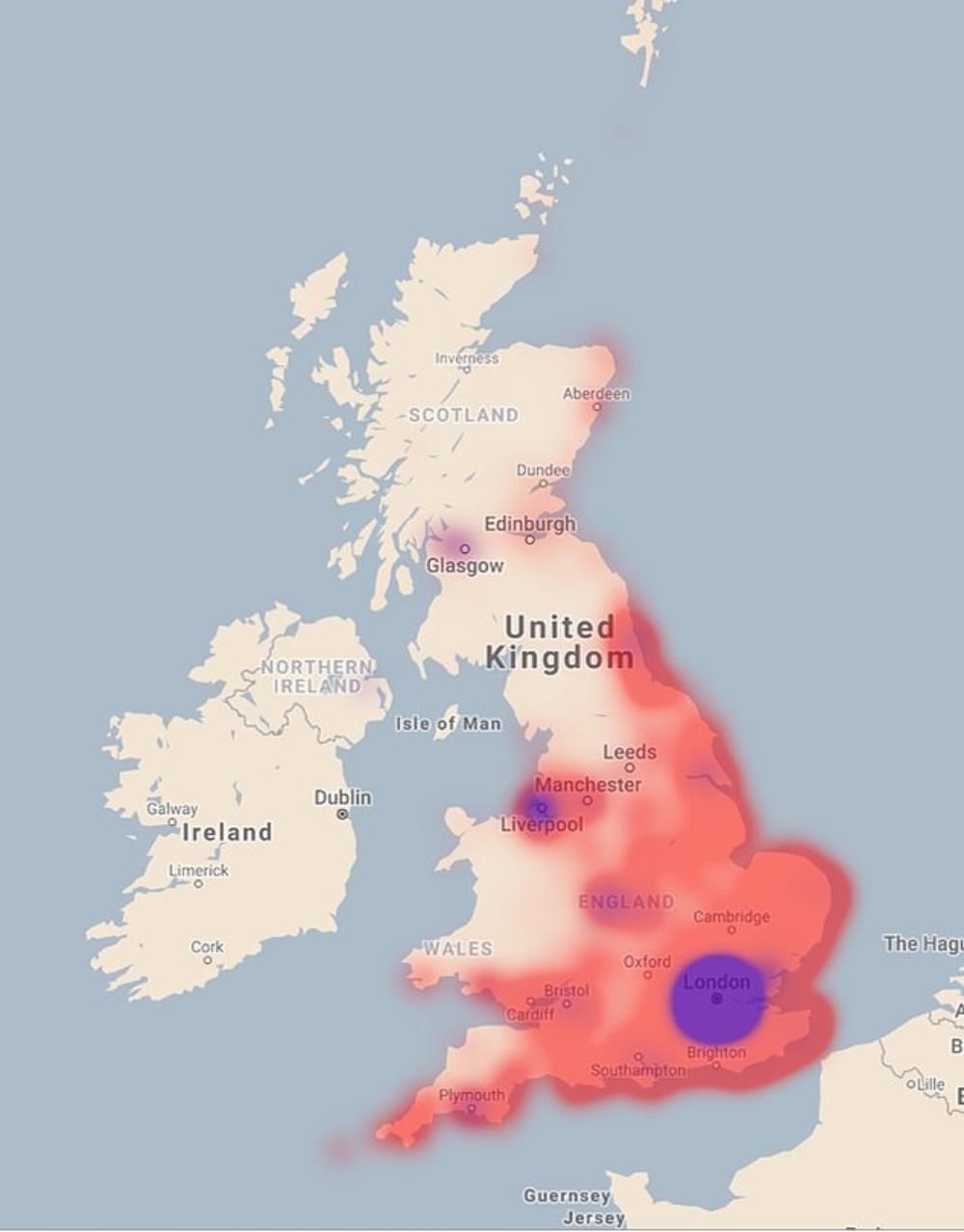North Queensferry School – the war years WWII Occupation and Evacuation
< Previous – pre WWII Air Raid Precautions
During the summer vacation of 1939, a detachment of Cameron Highlanders first occupied the school on 25th August.
Following the declaration of war on September 3rd 1919 came the announcement that the school would remain closed for an indefinite period.

The school remained closed through September. Concerns were raised in Parliament about the lack of air raid facilities in the village and the plight of the school children.
THE FIFE FREE PRESS, SATURDAY, SEPTEMBER 16, 1939
SHELTERS AT NORTH QUEENSFERRY
Sir J. Anderson’s Reply to Mr Gallacher
Mr Gallacher (West Fife) asked the Home Secretary in the Commons on Thursday, what protest he had received from North Queensferry, following his refusal to supply bomb-proof shelters, and would he circulate to the members of the House the report of his Scottish representative on the area.
Sir J. Anderson said no protests had been received by the Home Office or by his regional officer in Edinburgh against the policy which had been adopted for provided air raid shelters for Queensferry. The problem of providing shelter in this area was closely investigated on the spot by technical officers of his department. A comprehensive plan was drawn up and was now being put into operation.
It would be contrary to the usual practise to publish a report made by a departmental officer. The conclusions which he reached after consideration of the report had been fully explained in the letter he addressed to the member.
Mr. Gallacher, in a further question said the school was occupied, and something should be done immediately for the children.
Sir J. Anderson – I will look into that.
Meantime work began on the construction of a concrete shelter in the school playground.
The issue of air raid shelters in North Queensferry was raised again in Parliament on 14th September 1939
Mr. Gallacher asked the Home Secretary “what protests he has received from North Queensferry following his refusal to supply bomb-proof shelters; and will he circulate to Members of the House the report of his Scottish representative on this area?”
Sir J. Anderson
No protests have been received, either by the Home Office or by my regional adviser in Edinburgh, against the policy which has been adopted for providing air-raid shelter at North Queensferry. As the hon. Member is aware, the problem of providing shelter in this area was very closely investigated on the spot by the technical advisers of my Department and a comprehensive plan for dealing with it was drawn up and is now being put into operation.
It would be contrary to practice and open to strong objection in principle, to publish a report made by a departmental officer for the information of his official superiors, but the conclusions which I reached after consideration of that report have been fully explained in a letter which I addressed to the hon. Member and, as I have already informed him, I have no objection to his publishing that letter.
Mr. Gallacher
Is the Minister not aware of the deep feeling which exists in North Queensferry on this matter at the moment; is he also aware that only a concrete shelter is in course of construction in the children’s playground, and if he is not prepared to provide better facilities for protection in a place which could easily become a death trap, will he see that the school children, at any rate, are evacuated?
Sir J. Anderson
I was very anxious that the most rapid progress possible in the circumstances should be made in the provision of shelter in the area in accordance with the approved scheme. On the point about evacuation, I shall certainly consult with my right hon. Friend the Secretary of State for Scotland.
Mr. Gallacher
Is the Minister aware that there is no shelter there yet, although they are working at it and that the school is occupied by the military, and that therefore something should be done immediately for the children?
Sir J. Anderson
I will look into that.
On 20th September 1939 the focus in Parliament was on an evacuation scheme for North Queensferry
Mr. Gallacher asked the Secretary of State for Scotland whether he has considered the numerous complaints about defects in the working of the Scottish evacuation scheme; and what steps are being taken to remedy these defects?
Mr. Colville [John Colville MP Secretary of State for Scotland 6 May 1938 to 10 May 1940]
Difficulties were bound to arise in some areas in such a large and unprecedented movement of the population as that which has been undertaken. I have taken careful note of all representations which have been made to me with a view to remedying any well-founded complaints. All difficulties are discussed on the spot with the local authorities concerned by officers of the Department of Health and the arrangements for further transfers which are taking place have been framed in the light of the experience already gained.
Mr. Gallacher
While thanking the Minister for that reply, is he aware of the very deep feeling that exists in North Queensferry, which is very vulnerable, about the lack of anything being done for children; and will he consult with the authorities to secure the evacuation of these schoolchildren?
Mr. Colville
I will bear in mind what the hon. Member has put forward.
Then on 16th October came the first air raid of the war when planes attacked shipping in the Forth near the Forth Bridge.
This caused an immediate demand for the evacuation of children from North Queensferry.
EDINBURGH EVENING NEWS, TUESDAY, OCTOBER 17, 1939
MAY BE EVACUATED
CHILDREN IN NORTH AND SOUTH QUEENSFERRY
(From Our Lobby Correspondent)
Children in North and South Queensferry areas may be evacuated immediately, as a result of yesterday’s raid. Mr W. Gallacher, M.P. for West Fife, is having an interview with Mr John Colville, the Secretary for Scotland, on the matter tonight.
Mr Gallacher received today two telegrams. One from the North Queensferry Development Association, read: “Press evacuation. Absolutely necessary.”
The other telegram which was signed by Captain Lyle, read: “Re children at North Queensferry, will you please investigate question of evacuation of these children at once.”
Mr Gallacher went to the Home Office by he was referred to the Scottish Secretary, with whom he is to have an interview this evening.
An evacuation plan was speedily enacted, with registration opening on October 23rd
THE COURIER AND ADVERTISER, MONDAY, OCTOBER 23, 1939
NEXT FIFE EVACUEES REGISTER TO-DAY
At Inverkeithing and North Queensferry
Registration of Inverkeithing and North Queensferry school children for evacuation purposes will take place today and tomorrow at their schools between 2 and 5 p.m.
Parents only should attend. The children should be registered either at Inverkeithing or North Queensferry School, according to the area in which they reside no matter whether they attend a school outside those areas.
Later it may be possible to arrange for the evacuation of further classes such as blind persons and expectant mothers.
The topic was discussed in Parliament on 24th October 1939
Mr. Mathers asked the Secretary of State for Scotland whether the experience of the air-raid in the Forth area has caused the Government to examine afresh the question of classifying the burgh of South Queensferry as an evacuation area as urged by the town council; and whether he is in a position to make a statement there anent?
Mr. Colville
I have decided that in view of the special position of South Queensferry, North Queensferry and Inverkeithing they should be treated as sending areas under the Government evacuation scheme. Parents of school children have been given information about the arrangements and the registration of children whose parents desire them to be evacuated began yesterday.
Mr. Mathers
May I ask the right hon. Gentleman to what areas these children are to be evacuated, and whether it will be easy for their parents to visit them?
Mr. Colville
I would rather not say the exact district, but it will not be very far away from their present homes.
Mr. Woodburn
Will the right hon. Gentleman include other places on the Firth of Forth, such as Alloa and Kincardine, or at least stop sending children to those places which are within a bomb’s throw of the Forth Bridge?
Mr. Colville
The hon. Member will recollect that in a relatively small country no place can be declared to be completely safe. I shall be glad to consider any specific proposals, but there is only a limited amount of accommodation in the areas to which the children can be sent.
Mr. Woodburn
Does the right hon. Gentleman agree that the Firth of Forth is definitely a dangerous area and that bombs dropped from 20,000 feet might conceivably land in Alloa or Kincardine, which at the moment are reception areas?
Mr. Colville
Those places are much farther away than the Queensferry area, which I have agreed to evacuate.
Mr. Gallacher
Will the right hon. Gentleman make an inquiry into the position with regard to other villages right on the edge of the area which are affected in just the same way?
Meantime, a Barrage Balloon Squadron arrived in North Queensferry on 25th October 1939
Balloon Command was formed on 1 November 1938 and based at RAF Stanmore, Middlesex, under the control of Fighter Command. It operated the UK’s barrage balloon defences during the Second World War.
Barrage balloons were developed in the late 1930s as a countermeasure to bombing raids. A set of vertical steel cables attached to hydrogen-filled balloons formed a defensive curtain round the site of any potential target.
The balloons played a significant role in Britain’s anti-aircraft defences, as they restricted the freedom of German aircraft, often forcing them to fly different routes to a particular target and into anti-aircraft fire. Furthermore, the balloons’ highly visible presence boosted the morale of the civilian population.
The five groups making up the command were: No 30 Group, with its headquarters in Chessington, Surrey; No 31 Group, with its headquarters in Birmingham; No 32 Group, with its headquarters in Claverton, Somerset; No 33 Group, with its headquarters in Sheffield, Yorkshire; and No 34 Group, with its headquarters in Edinburgh.
The balloons were operated by auxiliary airmen, volunteers who were trained by the RAF. In July 1940, at the start of the Battle of Britain, Balloon Command consisted of 1,466 balloons, including around 450 over London.
On 24th August 1939, calling-out notices for auxiliary airmen arrived across the Home Counties exhorting the recipients to report for duty at their designated balloon station. (It was expected that the first targets for air raids would be in the area around London.)
Following the air raid in the Forth on 15th October 1939 a large company of volunteers were assembled at Chigwell in Essex. From there they were dispatched to various sites.
On 17th October a barrage balloon flight had been transferred from Glasgow to protect Edinburgh.
948 squadron of volunteers arrived in Inverkeithing on 25th October 1939 after a 12 hour train journey from Chigwell. The squadron comprised 4 Flights with responsibility for barrage balloons on the north shore of the Forth from Rosyth Dockyard to Methil.
‘B’ Flight’s mission was to protect area round the north end of the Forth Bridge.
Within 4 days balloon beds had been constructed, winches were in place and balloons were flying at each of nine sites around North Queensferry
The full story is told HERE
The Evacuation of North Queensferry continued
Registration for the government evacuation scheme was completed by October 26th 1939
THE SCOTSMAN, THURSDAY, OCTOBER 26, 1939
EVACUATION OF NORTH QUEENSFERRY CHILDREN
Registration Arrangements Now Completed
The registration of North Queensferry school children for the purposes of evacuation has now been completed following the decision pf the Government to evacuate to safe areas the school children, expectant mothers, and adult blind persons of Inverkeithing, North Queensferry and South Queensferry. There is in North Queensferry a school population of about 90.
Following the air raid on Monday, October 16, many of the parents caused their children to be removed to safe areas. These parents do not, therefore, come under the Government’s second scheme of evacuation.
Between those for whom provision has been made on a voluntary basis, and those for whom registration had taken place this week, provision has been made for the whole school population being billeted in reception areas at the beginning of next week.
The children are not to be accompanied by their mothers.
The first round of evacuation from North Queensferry was on 30th October 1939
35 children were given a medical examination and travelled to Saline and Steelend.
On 31st October a second round of evacuation was organized and 10 more children left for Saline on 6th November.
These were followed by the evacuation of women and pre-school children on 21st November 1939.

Evacuation issues
While the national evacuation scheme moved 500,000 people (mainly children) out of vulnerable areas (mainly in cities) to safer areas in the country, it was not without problems. By November 1939, many children had not been to school for three months, some were missing their parents and some parents were missing their children.
Evacuees began to drift back home, where with schools still closed, they were free to wander the streets.
The Evacuated Children Of The Second World War | Imperial War Museums (iwm.org.uk)
These issues were debated in Parliament on 21st November 1939. [link to Civil Defence and evacuation Nov 1939]
In Inverkeithing there were 700 children on the school roll, 90 registered for evacuation and 34 went.
In North Queensferry, there were 90 on the school roll. Of these, 45 children were evacuated under the government scheme; others may have been evacuated independently. Those who chose not to be evacuated attended Inverkeithing School.
[The situation in North Queensferry was different from that in Inverkeithing because the school was occupied by the military. So more parents may have elected for evacuation so that their children could attend school.]
The subject of a bomb shelter for North Queensferry was raised again in Parliament on 1st February 1940
Mr. Gallacher asked the Home Secretary which local authorities have submitted schemes for heavily protected air-raid shelters; which ones have actually carried out such schemes, and how many have been refused sanction so to do; and in what places have heavily protected shelters, as described in handbook 5a, been provided?
Sir J. Anderson
As I recently informed the hon. Member, local authorities have put forward a number of proposals for more strongly protected shelters. These proposals have generally been dependent upon the use of existing natural features capable of ready adaptation and, in pursuance of the Government’s policy, approval has not been given except when that was the case.
Mr. Gallacher
In the case of North Queensferry, so well-known to the Minister, in view of the fact that public servants there are right opposite the target, the Forth Bridge, will he not give encouragement to the provision of bombproof shelters along the cliff side?
Sir J. Anderson
No, Sir, I do not think that would be the best method of dealing with that particular case.
And again on 8th February 1940
Mr. R. Gibson asked the Home Secretary how many proposals for heavily protected air-raid shelters he has received from Scottish local authorities; how many of these were for deep shelters; how the proposals have been dealt with; and what was the regional distribution of the local authorities concerned?
Sir J. Anderson
I am advised that there have been proposals from five local authorities, namely Edinburgh, Glasgow, Dundee, Greenock, and North Queensferry. All involved the utilisation of some existing natural feature. In the case of Glasgow and of Greenock, the projects have not taken more than a very tentative form, while in the case of Edinburgh, certain objections were conveyed to, and apparently accepted by, the City authorities. The North Queensferry proposals, were rejected on the ground that the shelters would have been too remote to be reasonably accessible to those for whose protection they were designed. The Dundee proposal was approved by my Department, but I understand that other considerations have led the local authority not to pursue the matter further.
The Luftwaffe changes tactics.
After the air raid on the Forth in October 1939, things were relatively quiet until the heavy air raids of the Battle of Britain from 10 July until 31 October 1940, and the Blitz from 7 September 1940 to 11 May 1941.

Data from daily reports complied during the war revealed that London and the south-east were the worst hit, but the Luftwaffe bombers made it much further across the west and north of the UK than some realise (purple shows the most intense levels of bombing while the red indicates there were numerous attacks in that area)
The Bombing Britain website gives more information.
Click on “Essay” for an article about this topics
Click on “Data” to download an Excel spreadsheet which details every air raid.
On the nights of 13-14 and 14-15 March 1941 Luftwaffe bombers raided Clydeside and inflicted casualties in several industrial centres. Glasgow suffered the highest number of fatalities (about 650), but in proportion to its population of about 50,000 the burgh of Clydebank suffered the worst. According to an official count in 1942 the Clydebank raids killed 528 people and seriously injured 617, compared to totals of 1,200 people, and 1,100 in the whole of Clydeside.
The Clydebank Blitz 13 – 15 March 1941 | National Records of Scotland (nrscotland.gov.uk)
Heavy raids continued during 1942, but by 1943 hit and run raids with relatively few aircraft became more common.
< Previous – pre WWII Air Raid Precautions
> Next – North Queensferry School – the war years – WWII returning to normality
top of page
